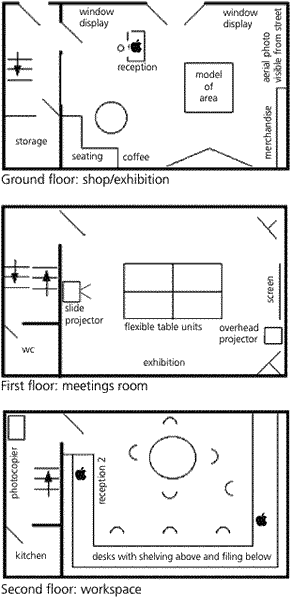Community Planning: Methods
Neighbourhood planning office
- description
- more detail
- more pictures
Neighbourhood planning offices provide an important local focal point for community planning activity and make it easier to follow up and sustain initiatives. Ideally every neighbourhood should have one, but they are particularly valuable in rundown areas or where there is a lot of building activity.
Neighbourhood offices should be in a prominent location, preferably with a shop frontage.
They provide a working base for all professionals dealing with an area, a venue for meetings and workshops and a first point of contact for local people on planning and building issues.
They should be staffed by people with project management skills able to take a pro-active role in pursuing improvement initiatives.
Neighbourhood offices should be in a prominent location, preferably with a shop frontage.
They provide a working base for all professionals dealing with an area, a venue for meetings and workshops and a first point of contact for local people on planning and building issues.
They should be staffed by people with project management skills able to take a pro-active role in pursuing improvement initiatives.
Photocredits
top: Lea View, Hackney, London, UK, 1982, Nick Wates.
bottom: Ball State University, Indiana, USA, 1994, Anthony Costello
top: Lea View, Hackney, London, UK, 1982, Nick Wates.
bottom: Ball State University, Indiana, USA, 1994, Anthony Costello

Resident resource
Local residents looking through product catalogues to specify design work on their homes.

Professional base
Architect helps residents at a weekly surgery at an office manned by trainees and volunteers.
Tips
- Neighbourhood planning offices often work best if managed by an independent body or partnership. Avoid total community control or total local authority control.
- Useful to base an office in a rundown building which can be renovated as a pilot project to stimulate other local improvements. Great scope for volunteers and trainees to run an office once it is set up.
- Combining a neighbourhood planning office with an environment shop, community design centre or architecture centre can be a powerful combination.
Costs
- Main costs: salaries, rent, heating, lighting, furniture and equipment. Costs can be reduced by seconding professional and technical staff and using volunteers to handle general enquiries and administration. From US$15,000 to $150,000 per annum.
Sample layout

Ideal layout for a well-resourced neighbourhood planning office with public shop/exhibition area, semi-public seminar room and private workspace. Minimum tolerable size: 375 square feet per floor (15 x 25). Even better if all facilities are on ground floor. If resources are not available, make do with whatever space you can find.
Checklist: Neighbourhood planning office information systems
- Community profile information
- Development plans
- Local history
- Local organisations and contacts
- Maps: varying scales
- Photos: Aerial, historical, current
- Planning applications
- Product catalogues
- Project files: AZ
- Property files: Building or plot
- Statutory plans
- .......................................

Before

Demonstration project
Before and after of a shop used as a neighbourhood planning office
and as a demonstration for improving street frontages.

Local presence
Architects set up office in a flat on a housing estate which they are rehabilitating.
Photocredits
top left and right: MUDStudio, Ball State University, Indians, USA, 1994, Anthony Costello
bottom: Hackney, London, UK, 1982, Hunt Thompson Associates
top left and right: MUDStudio, Ball State University, Indians, USA, 1994, Anthony Costello
bottom: Hackney, London, UK, 1982, Hunt Thompson Associates